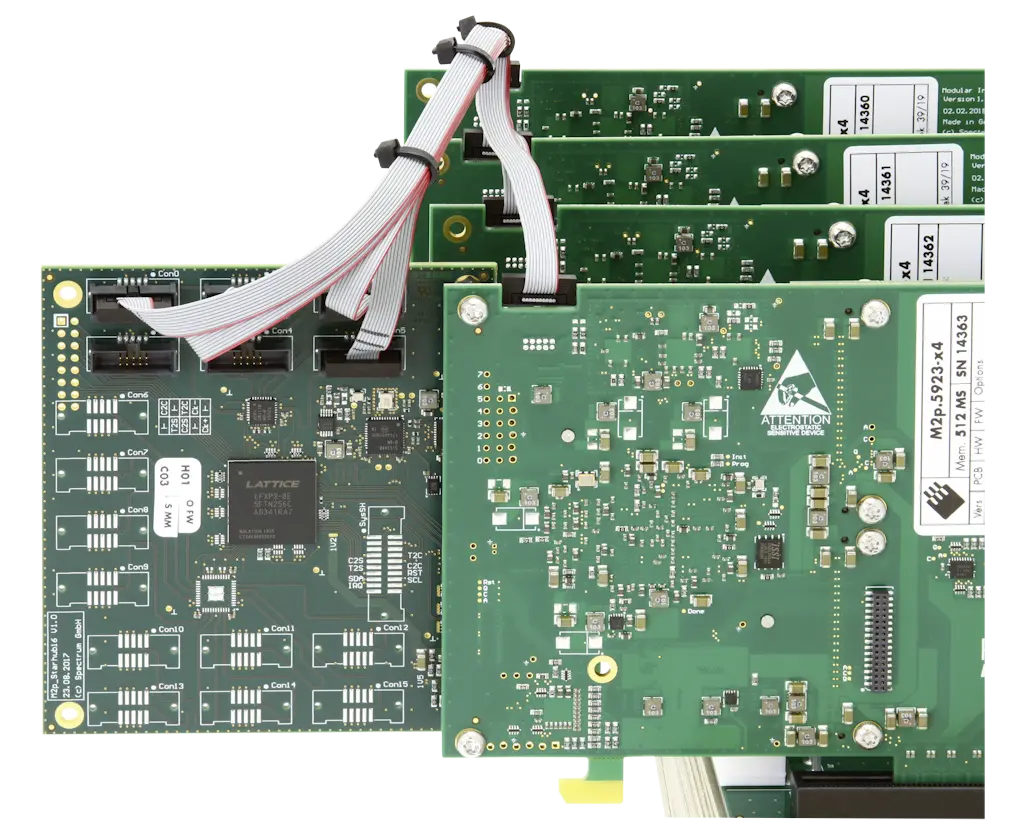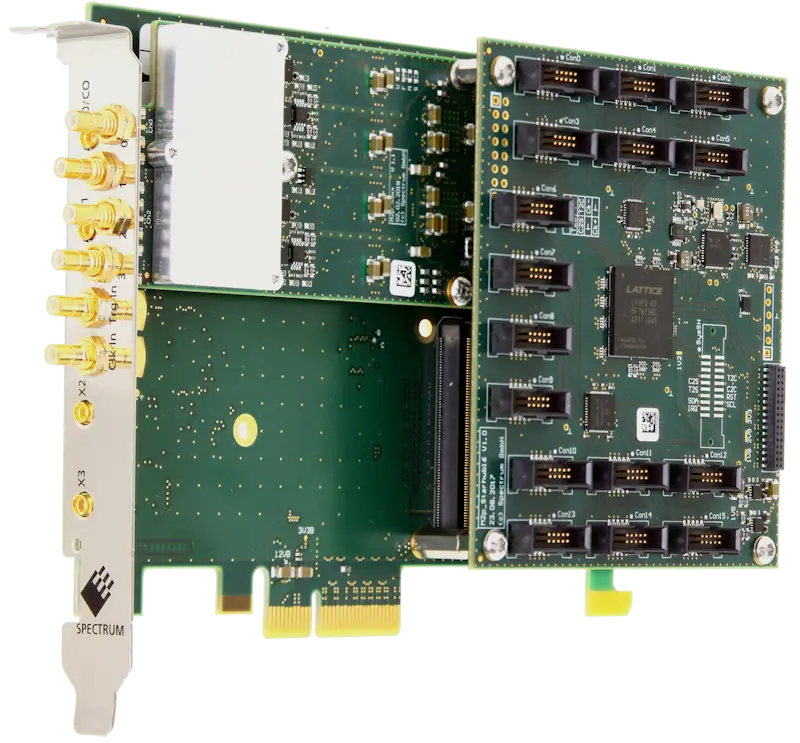-
Comparisons
-
Hardware Features
-
Systems
-
Software
-
Company
Knowledge-Base
- Hardware Features
- Synchronization
M2p Star-Hub
The Star-Hub modle is available in two different versions and allows the synchronization of up to 6 (small version) or 16 (large version) M2p cards in one system. The synchronization option was designed for system setup with a minimum phase delay and phase skew between channels. The connection of the boards is automatically recognized and checked by the driver at load time. The programming of the Star-Hub is included in the standard card interface and consists of only a few additional commands.
It is possible to synchronize any M2p board (Digitizer, AWG, Digital I/O) using the star-hub. The module acts as a Star-Hub for clock and trigger. Each board is connected with a small cable of the same length, even the master
board. That minimizes the clock skew between the different boards. The Star-Hub carrier board is the clock master for external clock. For internal clock and board can the clock master. Boards with different sampling rates can be synchronized by using integer dividers/multipliers between the clocks. For example one board can run with 100 MS/s, one with 50 MS/s and two more with 10 MS/s.
Any one or even several boards can be used as trigger sources for the complete system. The trigger source of all boards can be combined with logical OR. All trigger modes that are available on the master boards are also available if the synchronization Star-Hub is used.
Background
Theoretically, there are two issues when synchronizing instruments. The first is to arrange for a common trigger. The second is to have both instruments operate from a synchronized clock. As simple as this seems there are issues that arise when attempting to synchronize multiple digitizers.
The clock can be synchronized by using an external clock at the desired clock rate. A second method is to supply an external reference such as 10 MHz, this is then applied to a phase locked loop (PLL) which is used to multiply the frequency of the reference clock to the desired clock rate. The Spectrum M2p series cards used in this article handle both types of external clock through a common external clock input. The external clock input is connected to an internal PLL and this is set by the user to either multiply a reference clock or to phase lock to the external clock and pass it through without changing the frequency. This guarantees the correct frequency for the clock but does not guarantee that the clock in each digitizer has the identical phase.
On the trigger side of the synchronization process we have to consider that each digitizers external trigger input uses a separate comparator to detect the trigger level crossing. Small differences in reference level and differences in setup and hold times can result is discrete changes in the trigger point location in time, a form of trigger jitter.
The only way to guarantee exact synchronization of multiple digitizers is to distribute the clock to each module and to synchronize the trigger event to the system clock. In the Spectrum digitizers this can be done with the optional Star-Hub module.
Family Synchronization Possibilities
This list will be updated with each new M2p family release and shows how different families can be synchronized:
- 59xx: Digitizer with up to 125 MS/s: can be synchronized with any other M2p card
- 65xx: AWG with up to 125 MS/s: can be synchronized with any other M2p card
- 75xx: Digital I/O with up to 125 MS/s: can be synchronized with any other M2p card
Star-Hub Size
The star-hub is available in two different sizes:
- M2p.xxxx-SH6: star-hub for up to 6 M2p cards. This size is the standard and fits for any standard ATX or smaller PC which has a maximum of 7 slots (one for a graphics card)
- M2p.xxxx-SH16: star-hub for up to 16 M2p cards. This is the maximum number of cards that can be synchronized on one system. There are a few different system on the market that offer this number of slots in one system. Please contact Spectrum if you need help finding a solution for this number of cards.
Star-Hub Mounting Positions
There are two different mounting positions of the star-hub. The star-hub mounting is defined with the order of the options. Please check with the support team if you need to change the mounting position after delivery.
Option M2p.xxxx-SH6ex/SH16ex: extension
 The star-hub is mounted as an extension to a M2p card. The width of the card stays the same and it only needs one PC slot but the length of the card is extended to 3/4 PCIe length. Please make sure that your system can handle this size of PCIe cards. There is no difference in space considerations when using the SH6 or the SH16 version. Both versions will not occupy an adjacent slot.
The star-hub is mounted as an extension to a M2p card. The width of the card stays the same and it only needs one PC slot but the length of the card is extended to 3/4 PCIe length. Please make sure that your system can handle this size of PCIe cards. There is no difference in space considerations when using the SH6 or the SH16 version. Both versions will not occupy an adjacent slot.
Option M2p.xxxx-SH6tm/SH16tm: top mount
 The star-hub is mounted on top of the M2p card. The length of the card stays the same but the star-hub needs an additional slot width as it doubles the width of the card. There don't need to be a physical slot for the star-hub nor does it need a bracket.
The star-hub is mounted on top of the M2p card. The length of the card stays the same but the star-hub needs an additional slot width as it doubles the width of the card. There don't need to be a physical slot for the star-hub nor does it need a bracket.
Later extension of system
Any system setup can later be extended up to the maximum number of cards supported. All cards delivered are ready to be connected to a star-hub. If you start with one card you can simply start with a single plain card and buy a second card together with the star-hub option for extension later.